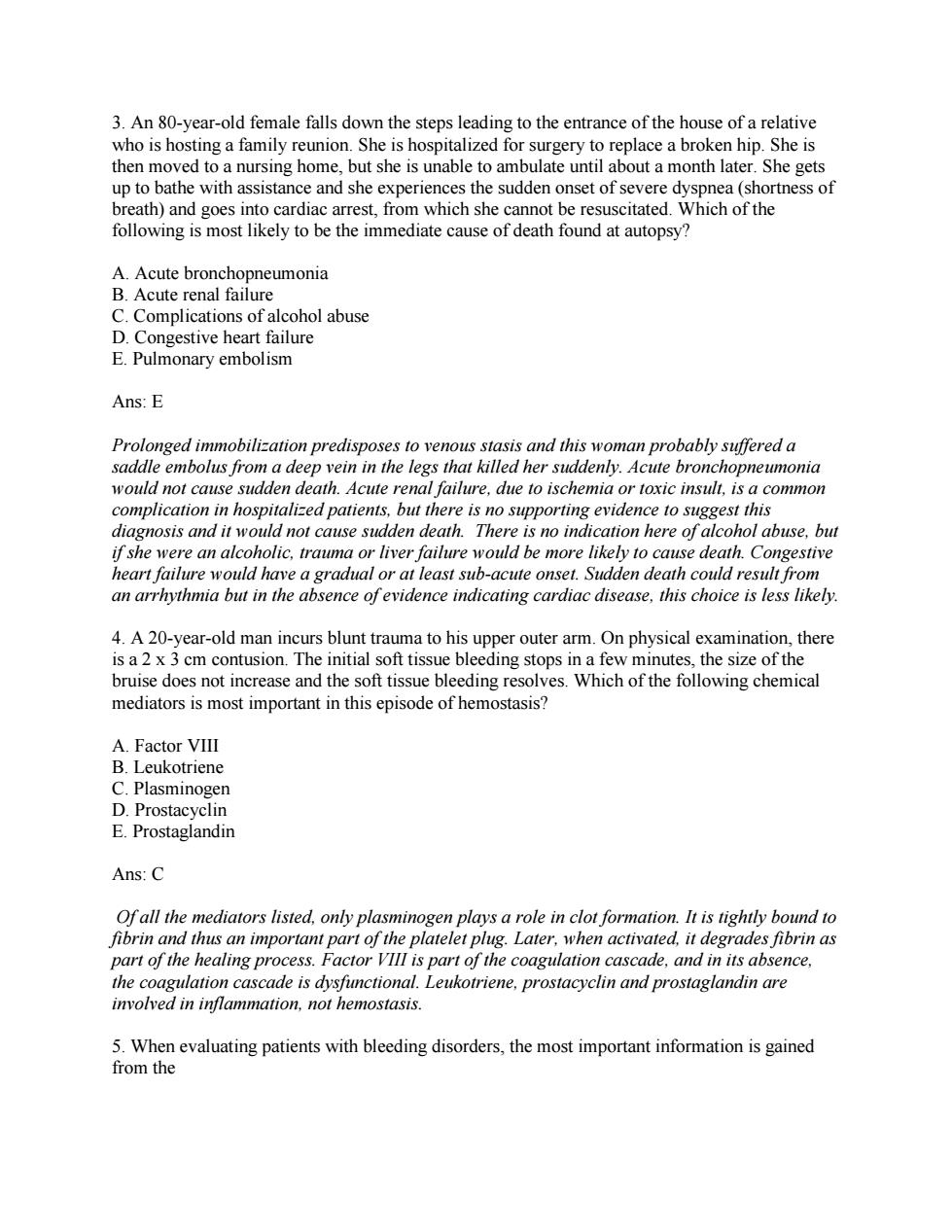正在加载图片...

3.An 80-year-old female falls down the steps leading to the entrance of the house of a relativ who is hosting a family reunion.She is hospitalized for surgery to replace a broken hip.She is then moved to a nursing home,but she is unable to ambulate until about a month later.She gets up to bathe with assistance and she experiences the sudden onset of severe dyspnea(shortness of breath)and goes into cardiac arrest,from which she cannot be resuscitated.Which of the following is most likely to be the immediate cause of death found at autopsy? A.Acute bronchopneumonia B.Acute renal failure C.Complications of alcohol abuse D.Congestive heart failure E.Pulmonary embolism Ans:E sis and this w man probably suffered a the le would e rena due to ischemic r toxic insult,i e088e den dea There is no indt on here of alco abuse,bu f she were an alco holic,trauma or liver failure would be more likely to cause ded th.Congestive heart failure would have a gradual or at least sub-acute onset.Sudden death could result from an arrhythmia but in the absence ofevidence indicating cardiac disease,this choice is less likely. 4.A 20-year-old man incurs blunt trauma to his upper outer arm.On physical examination,there is a 2 x 3 cm contusion.The initial soft tissue bleeding stops in a few minutes,the size of the bruise does not increase and the soft tissue bleeding resolves.Which of the following chemical mediators is most important in this episode of hemostasis? A Factor VIll B leukotriene C Plasmin D.Prost vclin ndir Ans:C mediators listed.on plasminogen plays arole in.is ihtly boud o us an important part of the platelet plug.Later.w s fibrin as part of the healing process.Factor VIll is part of the coagulation cascade,and in its absence. the coagulation cascade is dysfunctional.Leukotriene,prostacyclin and prostaglandin are involved in inflammation.not hemostasis. 5.When evaluating patients with bleeding disorders,the most important information is gained from the 3. An 80-year-old female falls down the steps leading to the entrance of the house of a relative who is hosting a family reunion. She is hospitalized for surgery to replace a broken hip. She is then moved to a nursing home, but she is unable to ambulate until about a month later. She gets up to bathe with assistance and she experiences the sudden onset of severe dyspnea (shortness of breath) and goes into cardiac arrest, from which she cannot be resuscitated. Which of the following is most likely to be the immediate cause of death found at autopsy? A. Acute bronchopneumonia B. Acute renal failure C. Complications of alcohol abuse D. Congestive heart failure E. Pulmonary embolism Ans: E Prolonged immobilization predisposes to venous stasis and this woman probably suffered a saddle embolus from a deep vein in the legs that killed her suddenly. Acute bronchopneumonia would not cause sudden death. Acute renal failure, due to ischemia or toxic insult, is a common complication in hospitalized patients, but there is no supporting evidence to suggest this diagnosis and it would not cause sudden death. There is no indication here of alcohol abuse, but if she were an alcoholic, trauma or liver failure would be more likely to cause death. Congestive heart failure would have a gradual or at least sub-acute onset. Sudden death could result from an arrhythmia but in the absence of evidence indicating cardiac disease, this choice is less likely. 4. A 20-year-old man incurs blunt trauma to his upper outer arm. On physical examination, there is a 2 x 3 cm contusion. The initial soft tissue bleeding stops in a few minutes, the size of the bruise does not increase and the soft tissue bleeding resolves. Which of the following chemical mediators is most important in this episode of hemostasis? A. Factor VIII B. Leukotriene C. Plasminogen D. Prostacyclin E. Prostaglandin Ans: C Of all the mediators listed, only plasminogen plays a role in clot formation. It is tightly bound to fibrin and thus an important part of the platelet plug. Later, when activated, it degrades fibrin as part of the healing process. Factor VIII is part of the coagulation cascade, and in its absence, the coagulation cascade is dysfunctional. Leukotriene, prostacyclin and prostaglandin are involved in inflammation, not hemostasis. 5. When evaluating patients with bleeding disorders, the most important information is gained from the